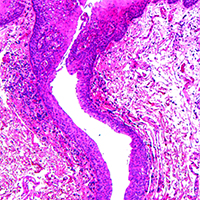 Smart Citations
Smart CitationsSee how this article has been cited at scite.ai
scite shows how a scientific paper has been cited by providing the context of the citation, a classification describing whether it supports, mentions, or contrasts the cited claim, and a label indicating in which section the citation was made.
Immunohistochemical study for relationship between vessel and lymphatic properties and tooth marks in human oral mucosa
Angiogenesis is an important issue related to normal growth and differentiation, and it is a critical issue in the progression of human disease in oral mucosa. Tooth marks occur after clenching the teeth for a long period under muscle tension in the human oral cavity. However, the sites of angiogenesis, cell differentiation and microvessel density are not known for human mucosa with tooth marks. Therefore, we investigated the relationship between the markers of differentiation (Ki-67), angiogenesis (CD31, D2-40, VEGF-A), and marks from teeth in the second molar region using immunohistochemical methods. In addition, we compared these areas with the mucous membrane. Our results revealed blood and lymphoid vessels in irregular mucosa structures, and the vessels in the oral mucosa were observed in three types of samples: dentulous, denture attachment (containing partial teeth), and edentulous samples. The localization of the angiogenesis was related to the structure of the oral mucosa of connective tissue in humans, such as the mucosal fold-like of the buccal region. Using principal component analysis (PCA), we found that tooth occlusal condition, gender, anti-VEGF-A reaction levels in oral mucosa of the epithelium were positive factors in all groups, which is in contrast to the negative association of Ki-67 reaction in the epithelium and CD31 expression. In addition, Ki-67 reaction in oral mucosa had negative impacts, in contrast to the positive association of D2-40. These PCA properties provide useful information for future study of tumour progression or mechanical stress in remodelling of oral mucosa and angiogenesis. Moreover, mechanical stress of the occlusal condition may be correlated with tumour angiogenic activity and cell differentiation in human oral mucosa.
How to Cite
PAGEPress has chosen to apply the Creative Commons Attribution NonCommercial 4.0 International License (CC BY-NC 4.0) to all manuscripts to be published.








